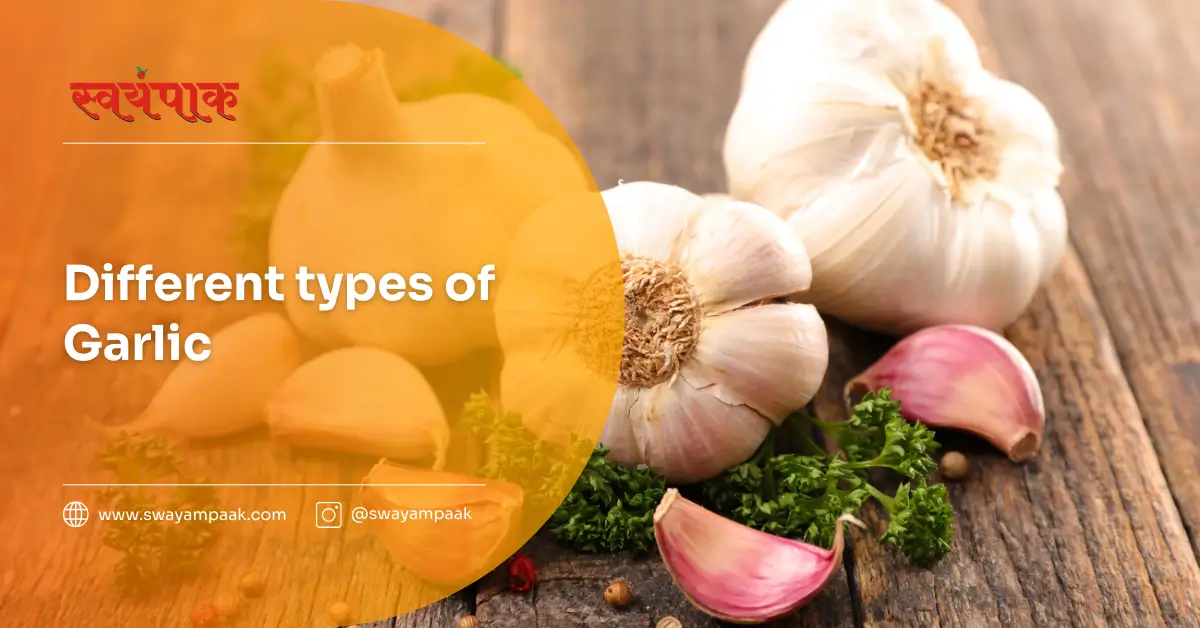Walk into any supermarket, and you’ll likely find just one type of garlic sitting in the produce section. But did you know there’s an entire world of different types of garlic waiting to be explored? From the gentle, buttery notes of Silverskin to the fiery kick of Rocambole, each type of garlic brings its unique character to the kitchen.
For thousands of years, cultures across the globe have cultivated different garlic varieties, adapting them to local growing conditions and culinary preferences. What started in Central Asia has evolved into hundreds of distinct varieties, each with its own flavour profile, growing requirements, and best uses in the kitchen.
Whether you’re a curious home cook, an adventurous gardener, or simply someone who believes that garlic makes everything better, understanding these varieties can transform your cooking. Let’s peel back the layers and explore the fascinating world of garlic – from common supermarket varieties to rare heirloom types that might just become your new kitchen staples.
What is garlic and what are the different types of garlic?
From ancient civilisations to modern kitchens, garlic has been revered as both a culinary powerhouse and a medicinal marvel. This humble bulb, scientifically known as Allium sativum, is far more diverse than the standard white variety found in most supermarkets.
While many cooks reach for the same garlic bulb for every dish, there’s a fascinating world of garlic varieties, each bringing its own distinct flavour profile, cooking properties, and growing characteristics.
From the common soft-neck varieties that grace our supermarket shelves to the complex-flavoured hard-neck types cherished by chefs, understanding these different types of garlic can transform your cooking from ordinary to extraordinary.
Artichoke Garlic
This variety dominates supermarket shelves for good reason. Named for its layered clove arrangement resembling artichokes, it produces large bulbs with multiple layers of cloves. Its mild, versatile flavour makes it perfect for everyday cooking.
When properly stored in cool, dry conditions, artichoke garlic can last 6-8 months. California Early offers a reliable harvest in spring, whilst Italian Purple brings a more robust flavour profile.
Artichoke Garlic Uses
- Ideal for everyday cooking and general-purpose use
- Perfect for garlic bread and marinades due to its reliable, mild flavour
- Excellent for garlic paste and purées
- Works well in slow-cooked dishes and stews
- Great for pickling and preserving
- Suitable for making garlic powder due to its good drying qualities
Silverskin Garlic
Prized for its stunning appearance and exceptional storage capabilities, Silverskin garlic features bright white, papery wrappers that make it ideal for traditional garlic braiding.
These varieties can last up to a year when stored properly, making them a favourite amongst gardeners and farmers. Nootka Rose stands out with its rosy clove skins, whilst Silver White offers consistently large, flavourful bulbs.
Silverskin Garlic Uses
- Excellent for dishes requiring raw garlic (salad dressings, aioli)
- Perfect for fine dining dishes due to its subtle, complex flavour
- Ideal for garlic-infused oils
- Great for Mediterranean dishes
- Works well in light sauces and vinaigrettes
- Beautiful for decorative braiding and kitchen display
Rocambole Garlic
Considered the connoisseur’s choice, Rocambole garlic delivers an intense, complex flavour profile with subtle sweet undertones that develop when cooked. Its loose, papery skins make it remarkably easy to peel, though this also means shorter storage life.
German Red offers robust, spicy notes, whilst Spanish Roja is celebrated for its rich, full-bodied flavour and excellent cooking qualities.
Rocambole Garlic Uses
- Perfect for roasting whole due to its rich, complex flavour
- Excellent in pasta dishes where garlic is a key flavour
- Ideal for garlic butter and compound butter
- Great for sautéed dishes and stir-fries
- Superb in pesto due to its strong flavour
- Works well in robust sauces and marinades
Porcelain Garlic
Distinguished by its pristine white wrappers and impressively large cloves, Porcelain garlic contains high levels of allicin, the compound responsible for garlic’s health benefits. Each bulb typically contains 4-6 enormous cloves, making preparation easier.
Music variety is renowned for its reliability and strong flavour, whilst Georgian Crystal offers a milder, more nuanced taste profile.
Porcelain Garlic Uses
- Ideal for medicinal purposes due to its high allicin content
- Perfect for dishes requiring fewer but larger cloves
- Excellent for grilling and barbecuing
- Great for hearty soups and stews
- Works well in strong-flavoured meat dishes
- Suitable for fermenting and black garlic production
Purple Stripe Garlic
These varieties showcase beautiful purple-striped wrappers and clove skins, making them visually striking. When roasted, the Purple Stripe develops an exceptionally sweet, complex flavour with caramel undertones.
Chesnok Red is particularly celebrated for its roasting qualities, whilst Persian Star offers striking purple colouration and robust flavour that holds up well in cooking.
Purple Stripe Garlic Uses
- Outstanding for roasting due to its sweet, caramelised flavour
- Perfect for baking whole in breads and focaccia
- Excellent in Mediterranean and Middle Eastern dishes
- Ideal for dishes where garlic is the star ingredient
- Great for garlic confit
- Works beautifully in rustic Italian dishes
Different Types of Garlic: Special Varieties
Black garlic is created through a month-long fermentation process, resulting in jet-black cloves with a sweet, umami-rich flavour reminiscent of balsamic vinegar. Solo garlic, or single-clove varieties, grow as one large clove, perfect for those seeking convenience.
Wild garlic (also known as ramsons) offers a milder, more delicate flavour and is foraged in British woodlands during spring.
Special Varieties Uses
Black Garlic:
- Perfect for high-end cuisine and umami-rich dishes
- Excellent in Asian cooking
- Great for spreads and dips
- Ideal for adding depth to sauces
Solo Garlic:
- Perfect for quick cooking needs
- Ideal for recipes requiring exact garlic measurements
- Great for single-portion cooking
Wild Garlic:
- Excellent in spring salads and pestos
- Perfect for foraged food dishes
- Ideal for subtle garlic flavouring
- Great in soups and risottos when in season
Uses of Different Types of Garlic in Different Cuisines
Mediterranean Cuisine
- Silverskin Garlic: Essential in aioli and raw preparations
- Traditional Spanish dishes use sweet Rocambole varieties
- Greek cuisine favours mild Artichoke garlic for tzatziki
- Italian cooking often uses Purple Stripe varieties for roasting
- Porcelain garlic preferred for robust pasta sauces and marinades
Asian Cuisine
Chinese Cooking
- Black garlic in braised dishes and sauces
- Solo garlic in quick stir-fries
- Artichoke garlic for everyday cooking and marinades
Korean Dishes
- Black garlic in high-end preparations
- Hardneck varieties for kimchi
- Porcelain garlic for medicinal soups and broths
Thai & Vietnamese
- Young garlic shoots in stir-fries
- Artichoke garlic in curry paste
- Silverskin in dipping sauces
French Cuisine
- Rocambole varieties for traditional confit
- Purple Stripe for roasting with herbs
- Porcelain garlic for rich sauces
- Artichoke garlic for everyday cooking
Indian Cuisine
- Artichoke garlic in curry bases
- Porcelain garlic for tandoori preparations
- Hardneck varieties in pickles
- Young garlic greens in dal
Middle Eastern Cuisine
- Purple Stripe varieties for roasting
- Rocambole in hummus and baba ganoush
- Silverskin in fresh herb mixtures
- Artichoke garlic in marinades
American/Modern Fusion
- Black garlic in upscale preparations
- Wild garlic in seasonal spring dishes
- Porcelain garlic in barbecue rubs
- Purple Stripe for grilling
Conclusion
As we’ve explored the rich tapestry of different types of garlic, it becomes clear that this humble bulb deserves far more attention than it typically receives. From the everyday Artichoke garlic brightening our weeknight meals to the complex Rocambole varieties elevating special occasions, each type brings something unique to our culinary adventures.
Understanding these differences isn’t just about becoming a garlic connoisseur—it’s about expanding your cooking possibilities. Whether you’re crafting the perfect Mediterranean feast, seeking the best variety for your home garden, or simply wanting to make the most flavourful garlic bread, choosing the right type of garlic can make all the difference.
Remember, while supermarket varieties serve their purpose well, exploring farmers’ markets, speciality grocers, or even growing your own can open up a world of garlic possibilities. Each variety, with its distinct characteristics and optimal uses, offers an opportunity to enhance your cooking in new and exciting ways.
As you continue your culinary journey, don’t be afraid to experiment with different garlic varieties. After all, the best way to understand these differences is to experience them firsthand in your own kitchen. Whether you’re roasting Purple Stripe, braiding Silverskin, or fermenting your own black garlic, there’s always something new to discover in the wonderful world of garlic.


